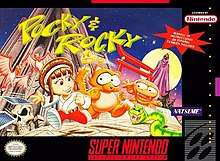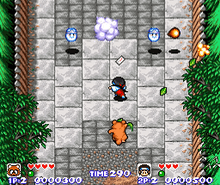Pocky & Rocky
Pocky & Rocky[lower-alpha 1] is a 1992 multidirectional scrolling shooter video game developed by Natsume for the Super Nintendo Entertainment System. It is the sequel to the 1986 arcade game KiKi KaiKai developed by Taito. Pocky & Rocky follows the adventures of a young Shinto shrine maiden named Pocky and her new companion, Rocky the tanuki as they attempt to save a group of creatures known as the Nopino Goblins. Gameplay takes place from a top-down perspective and features both single-player and cooperative modes. The game was generally well received by critics, and was followed by a sequel in 1994, Pocky & Rocky 2.
| Pocky & Rocky | |
|---|---|
 North American box art | |
| Developer(s) | Natsume[1] |
| Publisher(s) | Natsume[1] |
| Producer(s) | Yoshihino Hattori |
| Designer(s) | Yoshihino Hattori Shunichi Taniguchi[2] |
| Composer(s) | Hiroyuki Iwatsuki[2] |
| Platform(s) | Super NES |
| Release | |
| Genre(s) | Scrolling shooter[1] |
| Mode(s) | Single-player 2-player cooperative[5] |
Gameplay

Pocky & Rocky is a scrolling shooter video game that takes place from a top-down perspective.[6] The screen can move either horizontally or vertically and the player-controlled characters can move in eight directions.[1] The game features six levels and allows its players to continue indefinitely.[7][8] In single-player mode, the player can choose to play as either Pocky or Rocky. In two-player cooperative mode, both characters are on the screen at the same time.[8]
Pocky can use her ofudas to hit enemies from afar or swing her gohei to damage enemies close up.[7] Likewise, Rocky can throw leaves across the screen or quickly turn his backside and swing his tail.[9] Both characters can slide across the ground to cover area quickly. If a player bumps into the other while sliding in a two-player game, it will cause the other player to spin out of control across the screen, damaging any enemies they come in contact with. A limited-use special bomb attack can be used to hit several or all the enemies present on the screen.[10] There are some differences between both characters. Pocky moves and slides slightly faster than Rocky does. However, Rocky's slide attack goes a longer distance. Pocky's bomb attack is more powerful than Rocky's, although Rocky's bombs cover a wider area. Pocky can also perform a spinning attack whereas Rocky is able to transform into an invulnerable and immobile statue for a short time.[10]
Various power-ups can be acquired that will increase the effectiveness of either Pocky or Rocky's attacks, such as making their projectiles larger or giving them the ability to throw multiple ones at once. Others include a shield that absorbs enemy attacks,[1] and a power-up that replenishes hit points, giving Pocky and Rocky more endurance. A floating being called "Help man" is hidden in each level that will drop power-ups when found.[10]
Plot
Set in a Far East-themed world,[11] Pocky & Rocky is about a young miko[7] girl named Pocky (known in Japan as Sayo-chan (小夜ちゃん)) who is tending to a shinto shrine when she is visited by Rocky the Tanuki, or raccoon (known in Japan as Manuke (魔奴化)). Rocky is a member of a group of creatures known as the Nopino Goblins. Some time ago, the Nopino Goblins went insane, but were stopped and cured by Pocky. Rocky tells Pocky that the Nopino Goblins have gone insane yet again, and that she must help them. Suddenly, Pocky and Rocky are ambushed by the Nopino Goblins, which appear to be under a spell. Together, Pocky and Rocky must unravel the mystery of who is controlling the Nopino Goblins. Throughout the game, they battle a number of creatures from Japanese mythology, including kappas.[10]
Release
Pocky & Rocky was licensed by Taito to Natsume, who developed and published the game for release in Japan in 1992 and the rest of the world in 1993, it is the sequel to the 1986 arcade game KiKi KaiKai (unofficially released in North America as Knight Boy).[1][7] In Japan, Pocky & Rocky was broadcast on the Satellaview service on June 6, 1997.[12]
Reception
| Reception | ||||||||||||||
|---|---|---|---|---|---|---|---|---|---|---|---|---|---|---|
| ||||||||||||||
| ||||||||||||||
Pocky & Rocky was generally well received by critics, some calling the gameplay addictive. The two-player mode was considered by some reviewers to add a lot of value to the game. In addition, the controls were considered easy to pick up and play. On the other hand, some reviewers experienced slowdowns in frame rate. The graphics of the game, especially the backgrounds and enemies, received praise for being colorful and well-animated, many comparing it to The Legend of the Mystical Ninja in graphical style. The special effects and weather effects in the game were also well received by reviewers. However, some critics commented the lack of parallax scrolling and Mode 7 effects. The music and sound was positively received, and many critics thought it fit the theme and setting of the game well.[a]
Sequels
Pocky & Rocky spawned two official sequels and one spiritual successor. In Pocky & Rocky 2 for SNES, Pocky and Rocky must work together once again to stop a forced marriage between a princess and a tyrant.[16] In the second sequel, Pocky & Rocky with Becky for Game Boy Advance, the duo are joined by their friend Becky to stop a hydra dragon.[17] UFO Interactive Games later released a spiritual successor to the series called Heavenly Guardian, developed by Starfish for the PlayStation 2 and Wii video game consoles.[18]
Notes and references
Notes
- Pocky & Rocky is known in Japan as KiKi KaiKai: Nazo no Kuro Manto (奇々怪界 謎の黒マント, "Mysterious Ghost World: The Riddle of the Black Mantle").
- GamePro provided scores of 5/5 for graphics, 4.5/5 for sound, 5/5 for control, and 5/5 for fun factor.[6]
References
- "Import Review: Kikikaikai". Super Play. Future Publishing (5): 48. March 1993.
- In-game credits for the North-American release of Pocky & Rocky.
- "Pocky & Rocky release information for SNES". GameFAQs. Archived from the original on November 5, 2012. Retrieved January 28, 2013.
- "Super NES Games" (PDF). Nintendo of America, Web Archive. Archived from the original (PDF) on March 3, 2016. Retrieved January 28, 2013.
- "Kikikaikai". N-Force. Europress Impact (10): 32–33. April 1993.
- "Video-Game Reviews: Pocky & Rocky". GamePro. No. 45. International Data Group. April 1993. p. 74.
- Morales, Emill. "Kiki Kaikai Nazo no Kuro Manto / Pocky & Rocky - Super NES (1992)". Hardcore Gaming 101. Archived from the original on December 27, 2012. Retrieved January 28, 2013.
- "Video-Game Reviews: Pocky & Rocky". VideoGames & Computer Entertainment. No. 52. LFP, Inc. May 1993. p. 50.
- "Pocky & Rocky". Nintendo Power. No. 47. Nintendo of America. April 1993. pp. 26–29, 104, 109.
- "North American instruction booklet for "Pocky & Rocky" (SNS-KK-USA)". Natsume: 5, 8–15. Cite journal requires
|journal=(help) - "Pocky & Rocky". Total! (DE) (in German). MLV-Verlag (5): 46–47. October 1993.
- "Kiki Kaikai - Nazo no Kuro Manto". BS-X Satellaview, Web Archive. September 14, 2014. Retrieved December 29, 2017.
- "Pocky & Rocky". Super Power (FR) (in French). SUMO Éditions (13): 92–93. September 1993.
- "Test: Pocky & Rocky". Mega Fun (in German). Computec Media AG (9): 86–87. September 1993.
- "Buyer's Guide". Electronic Gaming Monthly. 1994.
- "Pocky & Rocky 2". Nintendo Power. No. 64. Nintendo of America. September 1994. pp. 30–37.
- Arushan, Zosha (July 14, 2002). "Pocky & Rocky with Becky: Preview". Nintendo World Report. Retrieved January 29, 2013.
- VanOrd, Kevin (April 18, 2005). "Heavenly Guardian Review". GameSpot. Archived from the original on October 25, 2012. Retrieved January 29, 2013.
- "Pocky & Rocky". Banzzaï (in French). Pressimage (14): 8. August–September 1993.
- "Kikikaikai Ninja". Total! (UK). Future Publishing (17): 36. May 1993.
- "Pocky & Rocky". Nintendo Power. No. 46. Nintendo of America. March 1993. p. 109.
- "Kiki Kaikai Ninja". Video Games (DE) (in German). Markt&Technik (19): 46. March 1993.